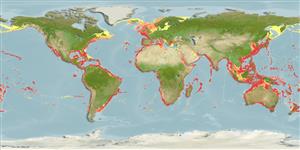Common names from other countries
Classification / Names / Names
आम नाम | उपशब्द | Catalog of Fishes (gen., sp.) | ITIS | CoL | WoRMS
Environment: milieu / climate zone / depth range / distribution range
पारिस्थितिकी
पिलाजिक; गहराई सीमा 0 - 800 m (Ref. 275). Tropical; 70°N - 44°S, 180°W - 180°E (Ref. 97142)
Circumglobal in warm and temperate oceanic waters.
Length at first maturity / आकार / वज़न / Age
Maturity: Lm ? range ? - ? cm Max length : 37.0 cm ML पुल्लिंग / अलिंग; (Ref. 97142)
Also caught using jigs (Ref. 417) and dip nets (Ref. 275). Medium-sized squid; mantle length up to 300 mm (370 mm only in the northern Pacific Ocean, Nesis 1982, 1987) (Ref. 97142). Oceanic, eurythermal, meso- and epipelagic species that occurs from the surface to 150 m depth and as deep as 4, 000 m. A schooling species frequently observed "flying" above the surface to escape predators in pursuit. Very dense muscular structure and high respiration rates confirm it is a fast-swimming, slow-growing species. Paralarvae are abundant in the eastern Atlantic Ocean, particularly from January to March. Spent females have severely degenerated muscular tissue of head, mantle, fins, as well as missing tentacles, so that they appear almost gelatinous. Prey consists of fishes and squids. Predators include giant red shrimp, fishes, e.g. albacore, yellowfin tuna, lancetfish, swordfish, tiger shark, smooth hammerhead shark, spinner, Frasier’s striped and Risso’s dolphins, toothed whales and fur seals (Ref. 97142).
Life cycle and mating behavior
परिपक्व अवधि | पुनरुत्पत्ति | मछलीऔ का अंडे देना | अंडे | Fecundity | लार्वा
Males mature earlier than females; synchronous oocyte development with high fecundity, i.e., more or less 200,000 eggs (Ref. 97142).
Roper, C.F.E., M.J. Sweeney and C.E. Nauen. 1984. (Ref. 275)
IUCN Red List Status (Ref. 130435)
CITES status (Ref. 108899)
Not Evaluated
Not Evaluated
Human uses
मात्स्यिकी: बाबत संभावित दिलचस्पी
| FishSource |
साधन
इंटरनेट स्रोत
Estimates based on models
Preferred temperature
(Ref.
115969): 7.6 - 23, mean 14.3 (based on 1813 cells).
Vulnerability
Low vulnerability (20 of 100).
